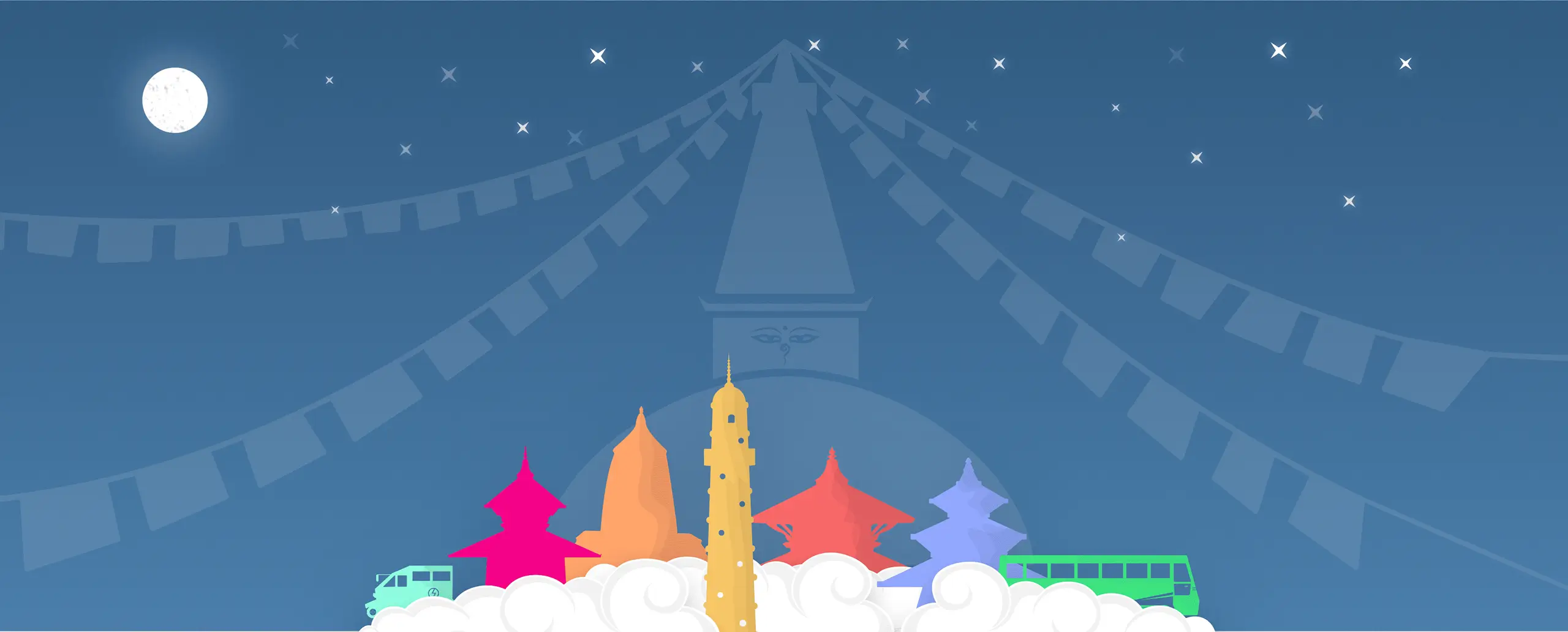Top 7 monsoon treks in Nepal | Plan Your Monsoon Trek Today |

The monsoon season in Nepal is approaching fast, and this is the perfect time to plan for a monsoon trek. In Nepal, the monsoon season starts from early June and often lasts till early September.
The monsoon breathes life into the vegetation, making it lush green - resulting in breathtaking landscape views. The monsoon rain also provides an earthy smell that will transport you to a different, often nostalgic, world.
So, wondering which monsoon treks provide you the best experience? Here are our recommendations.
1. Ghorepani Poon Hill Trek (5 days)
Ghorepani Poon Hill is a short and sweet trek that you can complete comfortably during the monsoon. This trek provides grand panoramic views of the mighty Annapurna and Dhaulagiri ranges in the Annapurna conservation area. In addition, you will also get to appreciate the Gurung and Magar cultures.
The trek starts from Pokhara and passes through Tikhedhunga, Ulleri, Ghorepani, Tadapani, Ghandruk, and back to Pokhara. The trails are quite good and comfortably support monsoon treks.
2. Nagarkot Trekking (3 days)
Nagarkot trek is a short trek away from the hustle and bustle of city life into the tranquil environment that allows you to enjoy amazing sceneries - including the mighty Everest, Ganesh Himal, Gaurishanker, Dorje Lakpa, Langtang, and Rolwaling.
The trek starts from Kathmandu and proceeds to Sundari Jal, Chisapani, and Haibung - before reaching Nagarkot. As you return, you will also visit Changunarayan Temple - one of the oldest temples in Kathmandu - in Bhaktapur.
This trek is for those who do not want to go far from Kathmandu Valley but still want to experience the pretty jungles, typical Nepali villages, and views from Chisapani and Nagarkot hilltop stations. Monsoon season is a perfect trek season for Nagarkot treks.
3. Upper Mustang Trek (15 days)

Upper Mustang lies in the rain shadow of the Himalayas, which means Upper Mustang is undisturbed by the monsoon. In fact, for this reason, people often refer to Mustang as the desert in the mountains. So, this is a perfect trek to complete during the monsoon.
Upper Mustang looks quite different from other parts of Nepal and is known for arid, barren land, red cliffs, ancient caves, and fossil rocks. Due to its proximity to Tibet, and as this region lies inside the Tibetan plateau, the settlements look more Tibetan than Nepali.
The trek starts with a flight from Kathmandu to Pokhara and then to Jomsom. As you trek to Upper Mustang, you will also see several tall mountains - including Mt. Annapurna (8,091m), Thorung Peak, Nilgiri (7,061m), Chulu East and West, Tukuche Peak, Dhaulagiri (8,167m), and Lamjung Himal.
4. Langtang Valley Trek (8 days)
It is one of the most popular treks in Nepal that takes you deep into Langtang National Park. Though Langtang Valley treks during monsoon are not very popular, if you love uncrowded trails that pass through dense blooming forests and spectacular waterfalls, you should certainly try this trek during this season.
Langtang trek begins with a drive north of Kathmandu, past Trishuli Bazaar to the Sherpa village of Syabru Bensi. The monsoon rain revitalizes the Langtang National Park, and you will have a greater chance to see wildlife like red pandas, Himalayan black bears, wild dogs, serows, snow leopards, musk deer, gorals, tahrs, and more than 250 bird species. And, of course, the rainwashed landscapes look very stunning.
5. Helambu Trek (7 days)
Helambu Trek is another trek that you can complete during the monsoon. The Helambu treks during monsoon are very safe, short, and rewarding. In addition, the trek elevation ranges from 800m to 3,600m only. The rain revitalizes the greenery in and around the trek region.
The Helambu region is home to Sherpas and Tamangs, so, this trek will provide you an insight into their lifestyle. You will also get a chance to visit several monasteries, stupas, and shrines. Of course, if you enjoy the mountain views, you can see Gauri Shankar, Langtang Lirung, and Ganesh Himal from the trek route.
The Helambu Trek begins from Kathmandu through Sundarijal to Chisapani and finishes at Melamchi Bazar, from where you will return to Kathmandu.
6. Everest View Trek (7 days)
Nepal is home to Everest, and lots of people visit Nepal to see Mount. Everest. Even though Everest Base Camp treks are possible during monsoon, they might get challenging. So, you have the option to trek in the Everest periphery to savor the beauty of this humongous mountain instead.
Everest View Trek starts with a flight from Kathmandu to Lukla and then a trek to Namche Bazaar - the gateway to Everest. You will first view Everest from Everest View Hotel and later from Tengboche.
Of course, there are other huge mountains that you will see - including two eight-thousanders - Mt. Lhotse (8,516m) and Cho Oyu (8,201m). You can also visit Edmund Hillary-funded school and hospital, a local yak farm, and Syangboche airport.
7. Annapurna Base Camp (7 days)

Annapurna Base Camp treks are world-renowned because of the diverse climate, geography, and ethnic villages. The good news is that you can complete Annapurna Base Camp treks during the monsoon.
The monsoon provides a green cover all over the trek region. It also keeps dust and pollution down. Due to rainfall, the rivers swell up, and the waterfalls look spectacular. However, you will have to be a bit careful because the route might be wet and slippery.
But, you will be rewarded with fantastic views of glorious snow peaks - including Annapurna ranges, Machhapuchre, Gangapurna, Khangsar, and Hiunchuli.
Choose your monsoon trek.
These are the seven most suitable Nepali monsoon treks for everybody. Choose your favorite trek and start planning for a monsoon trek with Discovery World Trekking. Call us at 977- 9840055491 or email us at info@discoveryworldtrekking.com.




.webp)






















